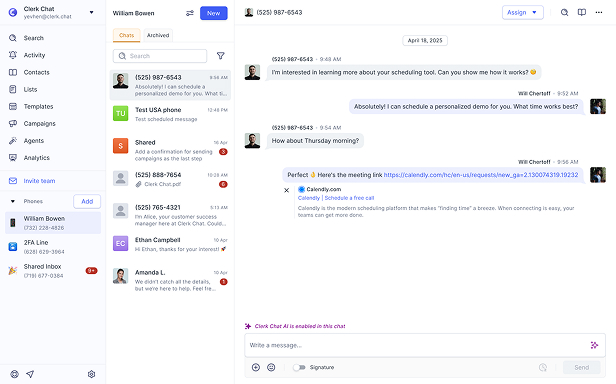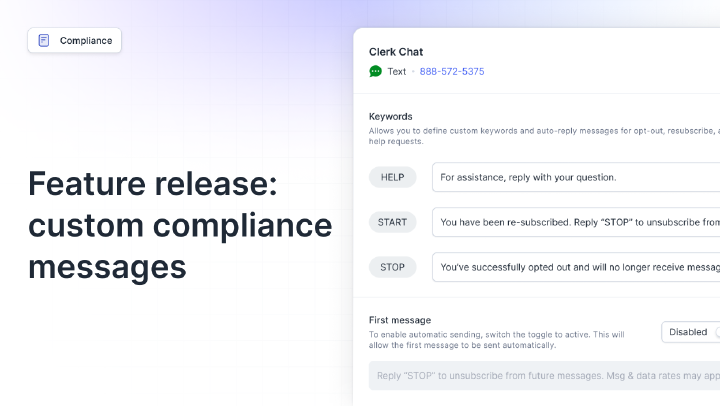Sender Reputation
[ˈsɛndər ˌrɛpjəˈteɪʃən]Sender reputation is a dynamic score that carriers and messaging platforms assign to phone numbers based on their messaging history, compliance adherence, and recipient engagement patterns.
Why Sender Reputation Matters
Sender reputation functions as your messaging credit score, directly determining whether your texts reach customers or vanish into digital oblivion. In an ecosystem where carriers process billions of messages daily, reputation scores help separate legitimate business communications from the 47% of SMS traffic classified as spam or fraudulent.
For businesses, sender reputation translates directly to bottom-line impact. A strong reputation means 95%+ delivery rates, faster message transmission, and priority routing during high-traffic periods. Poor reputation leads to filtered messages, delayed delivery, and eventual number blocking. When appointment reminders, shipping notifications, or authentication codes fail to deliver, the resulting customer frustration and operational disruption far exceed the cost of undelivered messages.
The stakes continue rising as carriers implement stricter filtering algorithms and regulatory requirements. What worked for SMS delivery in 2023 may fail today, as carriers now analyze sender behavior patterns across weeks and months rather than individual messages. This shift makes building and protecting sender reputation a strategic necessity rather than a technical detail.
How Sender Reputation Works
Sender reputation operates as a complex scoring system that continuously evaluates your messaging behavior across multiple dimensions. Each message you send contributes data points that either strengthen or weaken your standing with carrier networks.
The reputation ecosystem functions through interconnected components:
Data Collection: Every SMS generates metadata including timestamp, recipient response, delivery status, and content characteristics. Carriers aggregate this data across days, weeks, and months to identify patterns. A number sending 1,000 daily messages builds a behavioral profile that algorithms analyze for anomalies.
Scoring Algorithms: Carriers apply proprietary formulas weighing factors differently. Core components include:
- Delivery success rates (messages reaching intended devices)
- Engagement metrics (opens, clicks, responses)
- Compliance indicators (opt-out rates, consent verification)
- Content quality (spam triggers, formatting consistency)
- Sending patterns (volume stability, time distribution)
Cross-Network Intelligence: Major carriers share reputation data through industry consortiums. Poor behavior on Verizon’s network impacts your T-Mobile delivery rates. This interconnection means reputation management requires holistic thinking across all carrier relationships.
Dynamic Adjustment: Scores update continuously based on recent behavior weighted against historical patterns. A trusted sender experiencing sudden complaint spikes might see graduated penalties, while new senders face stricter scrutiny until establishing positive history.
Threshold Application: Different message types face different reputation requirements. Transactional messages (shipping alerts, password resets) may pass through with 70+ scores, while promotional messages might need 85+ for reliable delivery. Carriers adjust these thresholds based on network conditions and spam trends.
Best Practices with Sender Reputation
Start with warm-up periods - New numbers need gradual volume increases over 4-6 weeks. Begin with 50-100 messages daily to engaged recipients, doubling weekly as metrics remain strong. This establishes positive patterns before scaling.
Prioritize engagement quality - Focus on messages that generate responses and interactions. Two-way conversations build reputation faster than broadcasts. Include clear calls-to-action and reasons for recipients to respond.
Maintain list hygiene rigorously - Remove invalid numbers immediately as bounces damage reputation. Implement double opt-in for new subscribers. Scrub lists quarterly against carrier deactivation databases. Honor opt-outs within 24 hours.
Monitor metrics across carriers - Track delivery and engagement rates separately for each major carrier. A 95% average might hide 70% delivery to AT&T customers. Use this data to identify carrier-specific issues early.
Implement content variety - Avoid sending identical messages repeatedly. Use template variations and personalization. Carriers flag repetitive content as potential spam, even for legitimate notifications.
Establish sending consistency - Maintain regular daily volumes rather than burst sending. If you typically send 1,000 messages daily, suddenly sending 10,000 triggers scrutiny. Plan campaigns with gradual ramps.
Build reciprocal relationships - Design messaging programs encouraging customer responses. Appointment confirmations requesting replies, satisfaction surveys, and conversational support build positive engagement signals that boost reputation.
Real world examples
Common misconceptions
SMS sender reputation is equally critical and uses different scoring factors than email reputation systems.
Quality matters more than quantity - sending more messages without engagement actually damages reputation scores.
Each carrier maintains independent reputation systems with unique scoring algorithms and thresholds.
New numbers often begin with low trust scores and must gradually build positive reputation through compliant messaging.
While challenging, reputation can be rebuilt through consistent best practices and demonstrated compliance over time.
Related terms
In this article:
Ready to use your business number for text messaging?
Thousands of businesses are already experiencing the power of conversational messaging through SMS. Join us. Free trial and paid tiers available.
Get StartedFAQ
Have questions? We've got answers.
Find what you need quickly and clearly with our most frequently asked questions.
SMS sender reputation combines multiple weighted factors including delivery success rates, opt-out rates, spam complaints, message engagement (clicks/responses), sending consistency, content quality scores, and 10DLC compliance status. Carriers use proprietary algorithms weighing these factors differently - AT&T might prioritize opt-out rates while Verizon focuses on engagement metrics. Scores typically range from 0-100, with most carriers requiring 80+ for optimal delivery.
Sender reputation is your trust score based on messaging behavior and compliance history, while sender ID is simply how your number appears to recipients. Reputation is dynamic, changing based on your actions, whereas sender ID remains static once configured. A recognizable sender ID (like a branded short code) can help reputation by increasing recipient trust, but having a premium sender ID doesn't guarantee good reputation if you send poor quality messages.
Reputation can plummet within hours but takes weeks to rebuild. Sudden drops typically result from spam complaints, high opt-out rates (above 5%), sending to invalid numbers, dramatic volume increases, or compliance violations. A single campaign sending to an old list can drop scores by 20-30 points. Recovery requires 2-4 weeks of consistent best practices, with some carriers implementing 30-day probation periods after major violations.
Unlike email where tools like SenderScore provide visibility, SMS reputation scores remain largely opaque. Most carriers don't share exact scores, instead providing general health indicators through delivery rates and error codes. Some aggregators offer reputation estimates based on delivery patterns, but these are approximations. The best indicators are your actual delivery rates by carrier, engagement metrics, and whether you're experiencing filtering issues.
Poor sender reputation creates hidden costs beyond filtered messages. Low reputation leads to increased filtering (15-30% of messages), requiring oversending to reach audiences. Support costs rise as customers call about missing messages. Campaign ROI drops when time-sensitive messages arrive late or never. Some businesses see 40% higher per-successful-delivery costs due to reputation issues. Premium routing to bypass filters can cost 2-3x standard rates.
Recipient engagement serves as the strongest positive signal for reputation building. Carriers track response rates, link clicks, conversation continuations, and how quickly recipients engage. Messages generating 5%+ response rates significantly boost reputation. Conversely, messages that recipients ignore or immediately delete after reading hurt scores. Two-way conversations where recipients actively participate can improve reputation 3x faster than one-way broadcasts.




